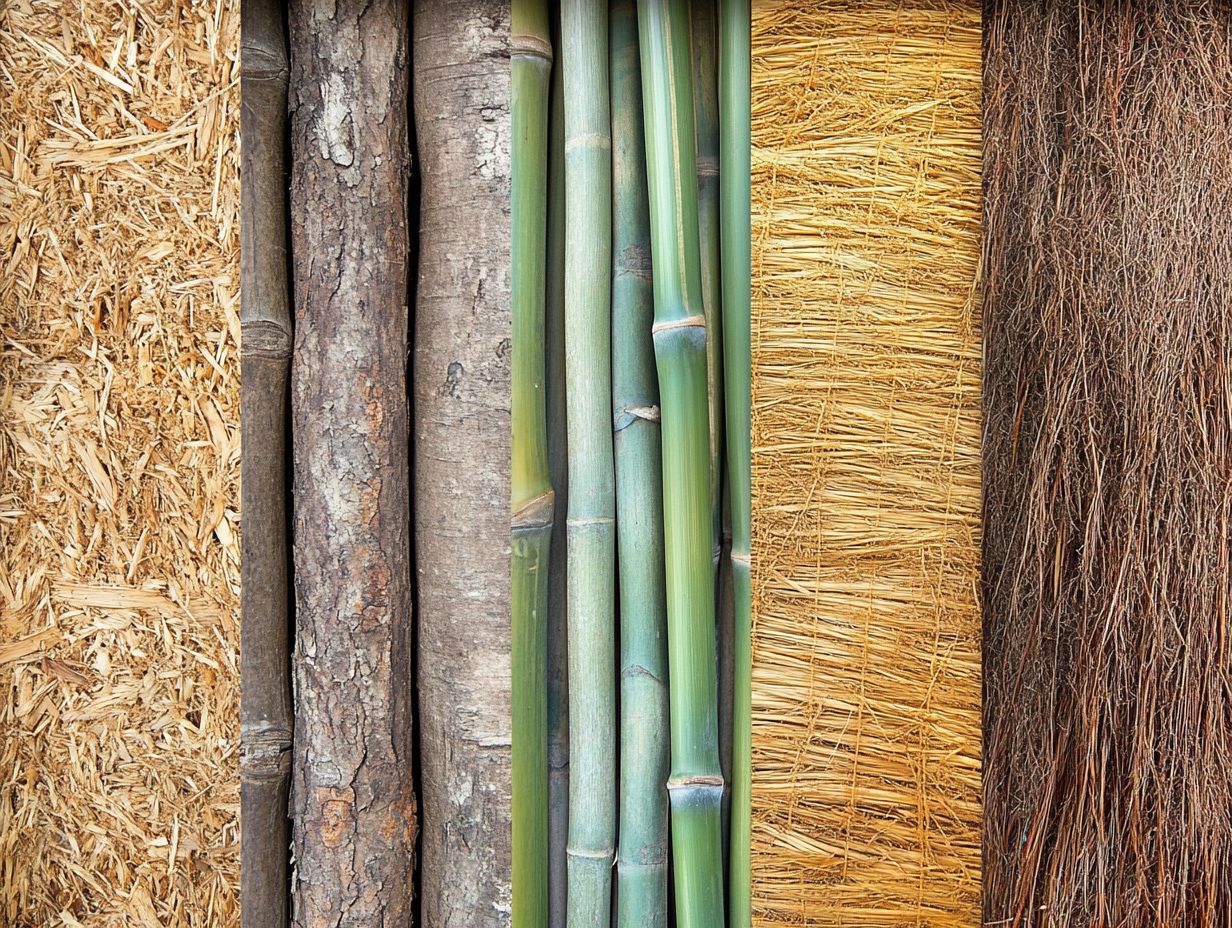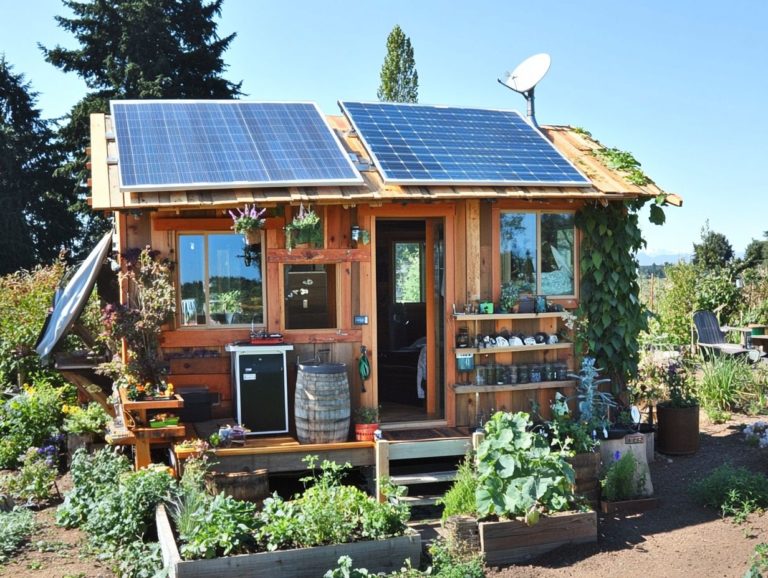5 Popular Natural Materials for Tiny House Construction
Building a tiny house isn t just about maximizing space; it s a chance to experience the joy of living sustainably.
Incorporating natural materials can elevate both the look and eco-friendliness of your compact sanctuary. From the inviting warmth of wood to clever applications of recycled materials, this piece delves into five popular natural options that can transform your tiny house into a cozy, sustainable haven.
This piece also covers the benefits, challenges, and costs tied to these choices, ensuring you re thoroughly prepared to make informed decisions for your build.
Contents [hide]
- Key Takeaways:
- 1. Wood
- 2. Straw Bales
- 3. Earth
- 4. Bamboo
- 5. Recycled Materials
- What Are the Benefits of Using Natural Materials in Tiny House Construction?
- Frequently Asked Questions
- What are the top 5 natural materials used for building tiny houses?
- What are the benefits of using natural materials for tiny house construction?
- How do wood and straw bales compare as natural building materials for tiny houses?
- What is the process of building a tiny house using cob?
- Why is bamboo a popular choice for tiny house construction?
- Can reclaimed materials be used for building a tiny house?
Key Takeaways:

- Natural materials, such as wood and straw bales, offer many benefits for tiny house construction, including sustainability and cost-effectiveness.
- Challenges of using natural materials include proper sourcing, the potential for pests and moisture damage, and limited availability in some areas.
- To ensure safety and durability, treat and maintain natural materials, and seek expert guidance during construction.
1. Wood
Wood is one of the most traditional building materials and plays a crucial role in eco-friendly construction. It helps tackle the housing crisis by providing sustainable options that reduce energy consumption and improve indoor air quality.
Its versatility allows you to use it in various ways. Pair wood with clever insulation techniques to boost comfort and efficiency in your tiny house.
Choosing reclaimed or engineered wood can lead to durable structures that are both beautiful and environmentally responsible, supporting the use of renewable resources. Sustainable wood types like bamboo and cork are increasingly popular due to their rapid renewability and minimal environmental impact.
Special timber designs enhance strength and contribute to energy savings by maintaining optimal indoor temperatures. Advanced wood treatment technologies, including natural preservatives, increase the longevity of wooden structures, reducing the need for harmful chemicals.
Natural grains and textures create a warm and inviting aesthetic, making wood a charming choice for anyone looking to blend sustainability with beauty in their living spaces.
2. Straw Bales
Straw bales stand out as an innovative and eco-friendly building material, renowned for their exceptional insulation properties and sustainability. If you’re aiming to address the housing crisis with cost-effective, energy-efficient construction methods, straw bales are an ideal solution.
These bales provide thermal resistance that can significantly lower heating and cooling costs. Their renewable nature also helps reduce environmental impact, aligning perfectly with a sustainable lifestyle.
Builders commonly use techniques such as stacking and plastering to enhance the durability and appeal of straw bale structures. However, addressing challenges like moisture control and pest management is essential to ensure these homes last.
Ultimately, using straw bales fosters a community-focused vision for sustainable housing, aligning with eco-conscious values and promoting resource efficiency and resilience.
3. Earth
Earth-based materials like cob construction and clay brick have become essential in sustainable architecture. They offer natural solutions that significantly cut energy consumption while fostering a healthy indoor environment, addressing the global housing crisis.
As you explore these practices, you’ll uncover the numerous benefits of materials like mycelium and hempcrete. Mycelium, a byproduct of fungi, is a lightweight, compostable insulation option with a minimal environmental footprint. In contrast, hempcrete, derived from industrial hemp, has remarkable energy efficiency due to its thermal properties, making it an exceptional choice for modern homes. Additionally, consider the advantages of reclaimed wood, a sustainable choice that complements these innovative materials.
These innovative materials not only help in reducing carbon footprints but also promote biodiversity and healthier ecosystems. They show that sustainability can be both practical and innovative in construction.
4. Bamboo

Bamboo is an incredible building material that renews quickly and impressively. It has gained traction in eco-friendly construction projects that tackle the housing crisis while promoting sustainable living practices.
This remarkable plant boasts incredible strength, often rivaling steel. Its natural flexibility enables it to withstand various environmental stresses, including earthquakes and heavy winds. By integrating bamboo into your designs, you can create structures that are resilient, lightweight, and visually appealing.
Architects have successfully used bamboo for everything from intricate trusses to entire homes, showcasing its impressive versatility.
Unlike traditional materials, which often require extensive resource extraction, bamboo thrives with minimal water and no pesticides. This makes it an eco-friendly choice that supports sustainable forestry practices and reduces carbon emissions.
5. Recycled Materials
The incorporation of recycled materials into construction practices marks a significant step toward eco-friendly solutions. These materials effectively address the housing crisis by minimizing waste and promoting sustainable building methods that enhance energy efficiency.
Among these materials, recycled steel stands out for its strength and durability. It is an excellent choice for structural frameworks, as producing recycled steel requires significantly less energy than virgin steel, thus lowering the carbon footprint linked to construction.
Reclaimed timber adds character to your builds while playing a vital role in capturing carbon. With innovative processes like repurposing old materials and advanced sorting techniques, companies are transforming what was once deemed waste into high-quality building resources.
These practices not only contribute to environmental preservation, but they also inspire a new generation of architects and builders dedicated to sustainable development.
What Are the Benefits of Using Natural Materials in Tiny House Construction?
Utilizing natural materials in your tiny house construction elevates aesthetic appeal while providing numerous benefits. You ll enjoy improved energy savings, enhanced indoor air quality, and a reduced carbon footprint all contributing to a sustainable lifestyle aligned with your eco-conscious values.
Consider a tiny house built from straw bales. It has excellent insulation properties, significantly reducing your energy costs for heating and cooling over time. Reclaimed wood adds charm to your space and repurposes resources that might otherwise go to waste, minimizing your environmental impact.
For instance, the Green House project utilized all-natural materials and reported improved indoor air quality, leading to better health outcomes for its residents.
These examples demonstrate how embracing natural materials can greatly enhance both your well-being and ecological sustainability. For more insights, check out the best materials for tiny house construction and consider incorporating these materials into your next build!
What Are the Challenges of Using Natural Materials?
While natural materials come with many benefits in construction, they also introduce specific challenges to consider carefully. Issues such as durability concerns, maintenance needs, and local availability are critical factors for builders and homeowners.
One primary hurdle is sourcing these materials, which can often be limited by geography or season. This variability complicates efforts to maintain consistent quality and supply.
While natural materials have their charm, they can sometimes compromise the strength of the structure, especially during adverse weather or over time. This highlights the importance of having a thorough understanding of the properties of these materials.
To tackle these challenges, consider incorporating engineered alternatives or adopting hybrid approaches that combine natural materials with sustainable technologies. This strategy could yield a more resilient solution. Establish regular maintenance plans and provide training to help homeowners care for these materials effectively, ensuring the longevity and performance of your natural choices.
How Can One Ensure the Safety and Durability of Natural Materials in Construction?

Ensuring the safety and durability of natural materials in construction requires a proactive approach. Embrace innovative insulation techniques, proper treatment methods, and rigorous building standards to create resilient and safe living environments!
To achieve this, explore treatment options like environmentally friendly preservatives or fire-retardant chemicals designed for natural substances. Adopting modern building practices, such as structural bracing and moisture management, can significantly enhance the lifespan of these materials.
It s essential to stay compliant with relevant codes, such as those set by the International Building Code (IBC) and the National Fire Protection Association (NFPA). This ensures your constructions meet safety regulations while incorporating cutting-edge methods for thermal performance and energy conservation.
What Are the Costs Associated with Using Natural Materials?
The costs associated with using natural materials can vary significantly, influenced by factors like sourcing, processing, and labor. However, these choices often lead to long-term savings through reduced energy consumption and lower maintenance costs!
For instance, while the initial investment in sustainably sourced hardwood or bamboo may seem higher than that of traditional materials, their exceptional durability means you ll save money and time by avoiding frequent replacements! Natural materials like cork or sheep wool provide remarkable insulation properties, significantly decreasing your heating and cooling expenses.
As eco-friendly options continue to evolve, innovative technologies are emerging that enhance their affordability, making them increasingly appealing alternatives. By implementing these materials, you contribute to a healthier environment while paving the way for significant savings over the lifespan of a building or product.
How Can One Incorporate Natural Materials into the Design of a Tiny House?
Incorporating natural materials into your tiny house design requires a blend of thoughtful planning and creativity. Focus on elements such as a compact layout, quality windows that invite ample natural light, and wood sourced from responsibly managed forests to craft a harmonious and functional living space.
These features not only elevate the aesthetic appeal. They also nurture a sense of well-being by connecting you to the great outdoors. Consider using reclaimed wood for flooring and cabinetry. It brings warmth and character while ensuring durability.
An open layout maximizes space efficiency, fostering a flow that feels both inviting and practical. Take inspiration from the inspiring ‘Tiny Mountain House’ in Colorado for amazing ideas!
Its natural stone exteriors and expansive glass doors exemplify how to seamlessly merge indoor and outdoor environments. This design fully capitalizes on available light and stunning views.
Frequently Asked Questions
What are the top 5 natural materials used for building tiny houses?

The top 5 natural materials used for building tiny houses include wood, straw bales, cob, bamboo, and reclaimed materials.
What are the benefits of using natural materials for tiny house construction?
Natural materials are environmentally friendly and renewable. They have a lower carbon footprint than traditional building materials. They also offer better insulation, durability, and a unique aesthetic appeal.
How do wood and straw bales compare as natural building materials for tiny houses?
Wood is a strong and versatile material. Straw bales provide excellent insulation and are affordable. They both have their advantages and can be used in combination for a sturdy and energy-efficient tiny house.
What is the process of building a tiny house using cob?
Cob is a natural building material made of clay, sand, and straw. The process involves mixing these materials together, shaping them into walls, and allowing them to dry naturally. It is a labor-intensive but cost-effective method for building a tiny house.
Why is bamboo a popular choice for tiny house construction?
Bamboo is a fast-growing and sustainable material. It is strong, lightweight, and flexible. It has a natural resistance to pests and moisture, making it an ideal choice for building tiny houses in different climates.
Can reclaimed materials be used for building a tiny house?
Yes, reclaimed materials such as salvaged wood, metal, and bricks can be used for building a tiny house. Not only does this reduce waste, but it also adds character and charm to the overall design of the house.
Ready to start your tiny house journey?






